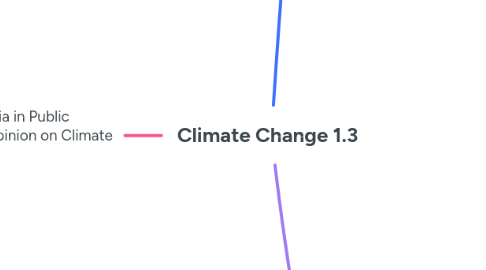
1. 3. The role of Media in Public Perception and Opinion on Climate Change
1.1. Media have weakened the climate change arguments in the public mind in 3 ways
1.1.1. False Balance
1.1.1.1. Media present the climate change debate as more of a question than it really is
1.1.1.1.1. In an attempt to provide a balanced discussion, some media organisations, including BBC have been accused of false balance
1.1.2. Politically influenced reporting
1.1.2.1. Most people rely on popular media reporting
1.1.2.1.1. Depending on political leanings of media organisations, reporting may be deliberatley slanted
1.1.2.2. Guardian/Left leaning news papers presents climate change as important and everyones responsibility
1.1.2.2.1. Where right wing organisations would present less screen time for climate change and portray sceptical views
1.1.3. Simplistic and sensationalist reporting
1.1.3.1. An overwhelming majority of climate scientists believe in human-caused climate change
1.1.3.1.1. However the issue remains controversial
2. 1. Historical background of the global warming debate and how it has evolved over time
2.1. Timeline of scientific debate surrounding global warming
2.1.1. 1824
2.1.1.1. First greenhouse effect discovered
2.1.2. 1862
2.1.2.1. John Tyndall first suggests water vapour and co2 trap heat
2.1.3. 1896
2.1.3.1. Swedish scientist observed co2 is an absorber of long wave radiation
2.1.4. 1938
2.1.4.1. Link between global warming to emissions of co2 from burning fossil fuels
2.1.5. 1957
2.1.5.1. Suess and Revelle discover chemical process which limited capacity of oceans to absorb co2
2.1.6. 1958
2.1.6.1. Measurements of atmospheric co2 begin in Mauna Lao in Hawaii
2.2. Political debate
2.2.1. 97% of scientists support the view that global warming is taking place due to human causes
2.2.1.1. Some suggest rising temperatures are due to increased solar output and volcanic activity
2.2.2. Ironically the worlds biggest coal exporters are the biggest climate change deniers
2.2.2.1. Their political view is impacted by the money that flows into country through fossil fuel industries
2.2.2.1.1. Indonesia are the biggest climate deniers, yet the biggest coal exporters
2.2.2.1.2. Australia
2.2.3. Some argue the science isn't good enough
2.2.3.1. In other words it is cheaper to ignore the problem
2.2.4. Lack of sufficient education impacts these views
2.2.5. Climate lobbying
2.2.5.1. Funding of political campaigns and figures that support blocking climate change policies
3. 2. Role of governments and international organisations in shaping the debate of climate change
3.1. United Nations
3.1.1. Tends to follow the science taking the proactive approach to climate change
3.1.2. United Nations Framework Convention on Climate Change
3.1.2.1. Established in 1992 to create international co-operation to combat climate change
3.1.3. How have the UN shaped the debate on climate change
3.1.3.1. UNFCCC provide a climate meeting annually since 1992
3.1.3.1.1. Not legally binding, but created framework for protocols to take place
3.1.3.2. Kyoto Protocol
3.1.3.2.1. A legally binding agreement put into force in 2005
3.1.3.3. Paris Agreement in 2016
3.1.3.3.1. Keep warming below 1.5 degrees
3.2. European Union
3.2.1. By 2020 all EU members given a goal to reduce emissions by 20%
3.2.1.1. An ambitious target
3.2.2. EU Emissions trading system
3.2.2.1. Covers 45% of emissions from the EU
3.2.2.1.1. A cap and trade scheme targetting a 21% reduction in emissions from power stations, industry and aviation
3.2.2.2. Companies are given individual caps and pay penalties if they exceed that cap
3.2.2.2.1. The trade enables companies to buy and sell allowances encouraging them to save money by cutting emissions
3.2.2.3. Success?
3.2.2.3.1. Successful in reducing emissions
3.2.2.3.2. Isn't a total success in every element
3.3. The UK
3.3.1. UK strategies
3.3.1.1. Carbon budgets
3.3.1.1.1. 5 year period stepping stones towards 2050 target
3.3.1.2. Carbon taxes
3.3.1.2.1. Aims to switch electricity generation from coal to greener fuels
3.3.1.3. Reduced demand for energy
3.3.1.3.1. Domestic smart meters allow for better energy efficiency in homes
3.3.1.4. Low carbon technology
3.3.1.4.1. Carbon capture and storage
3.3.1.4.2. Renewable energy
3.3.2. Trying to tackle climate change on a national scale
3.3.2.1. Shaping the debate on climate change minimally but the UK is setting an example at international summits
3.4. India
3.4.1. India did not ratify Kyoto protocol
3.4.1.1. The government argued rich countries should bear the cost of reducing emissions
3.4.1.1.1. This view, shared with china, prevented the USA from supporting kyoto
3.4.2. India's Case
3.4.2.1. Its per capita energy consumption (1.7 tonnes) is well below average of 5 tonnes
3.4.2.2. Its priorities were alleviating poverty
3.4.2.2.1. One of the ways to do this was expanding electricity access in India, not reducing emissions
3.4.2.3. Current high concentrations of CO2 in the atmosphere were as a result of industrialisation of current AC's
3.4.2.3.1. At 2014 conference the environment minister stated that India would not consider reducing emissions for 30 years
